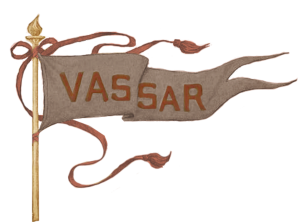Faculty of Vassar College
held
May ninth, nineteen hundred
and eighty—four, the following
Memorial
was unanimously adopted;
Edna Cers Macmahon, Professor Emeritus of Economics was born
February 27, 1901 in Riga, Latvia, the daughter of John William and
Alvia Julia Lischmann Cers. Her family emigrated to the United States
when she was a child and she grew up on a farm in Massachusetts. Edna
began her long career of community service by sharing with neighboring
farmers helpful information from her careful reading of agricultural
bulletins. A favorite teacher persuaded her to change her original
plan of going to a normal school; instead, she entered Radcliffe at
age l6, working her way through college. A seminar with Frederick
Jackson Turner inspired her life-long fascination with the influence
of the frontier and of geographic mobility upon American history.
At age 20 Edna began graduate work at Bryn Mawr On the Susan
B. Anthony scholarship. The next summer, in 1922, she met her future Vassar colleague, Margaret Myers, when they both led discussion groups at the School for Women Workers in Industry held at Bryn Mawr. When they learned that youn women on strike at a Philadelphia clothing factory were being arrested illegally, they decided to provide publicity by getting themselves arrested at
-2-
the strike site. With support from a young male friend from an Old
Philadelphia family, they began interviewing the strikers On the
picket line. The police hustled them off to the city jail where they
briefly shared a cell next ta a young woman who called out cheerfully:
"What are you in for? shoplifting?" The venture ended with a double
standard in sentencing which left them furious; their male friend
was fined, but the future Vassar economists were let off with nothing
but an admonition.
In 1923 Columbia University appointed Edna as the first woman to
hold its Gilder Research Fellowship. At Columbia she studied under
Wesley Clark Mitchell, pioneer institutional economist, whose course
on economic theory provided the framework for her thinking about
economics. From her studies with Mitchell and with two other famous
institutionalists, Thorstein Veblen and John R. Commons, she drew the
lesson that economists should be critics and shapers of the societies
they study. In 1924 she accepted a fellowship from the newly-founded
Robert Brookings Graduate School of Economics and Government, an
experiment in studying at the intersection of theory and public policy.
She received her Ph.D. in 1930 with a doctoral thesis on labor injunctions.
While working toward her doctorate, she investigated child labor in
Maryland and Delaware canneries for the Children's Bureau of the United
States Department of Labor. She also worked for the District of
Columbia Consumers‘ League in 1926 as it brought pressure for the
enforcement of District laws on maximum hours for women. In 1927, while
employed by the U. S. Chamber of Commerce, she began a study of immigrae
tion which continued subsequently for the Council on Foreign Relations.
But with teaching her long—term goal, she was glad in 1929 to become an
-3-
instructor of economics at Hunter College.
In that year Edna married Arthur Whittier Macmahon, then associate professor and subsequently Eaton professor of public administration at Columbia University. They had two children: Gail, now living in Austria where her husband is a diplomat, and Alan, now a physicist at the University of Texas. During their childhood, the family lived
in Croton where Edna helped run a cooperative school inspired by what
remains durable in John Dewey's theories of education. She also ran
an annual plant sale for the school notable for the stream of varied
advice that accompanied her sales as she visualized each purchaser's
plot, its probable disadvantages of soil or shade, and the owner's
probable lack of time or knowledge.
In later years members of the Vassar community would benefit
from Edna's advice on gardening and from the well—developed aesthetic
imagination which informed it. That imagination could be seen in the
gardens and houses she arranged, and especially in the beloved cottage
at Lake Awosting with its wonderful relating of domestic comforts,
works of craftsmanship, and the natural beauty of the setting.
While still at Croton in the late l93Os, Edna began to travel for
research and for consulting assignments. In 1941-42 she served as
Director of Research for the Division of Minimum Wage and Women In
Industry of the New York State Department of Labor and also headed
the Economics unit in the Consumer Division of the Office of Price
Administration.
Edna joined the Vassar faculty in 1942. At that time the Vassar economics department was part of a joint department, economics and
-4-
sociology, which would shortly become the economics, sociology, and
anthropology department-—E.S.A. Edna found the philosophy of the
department to her liking. Abstract theory was not for her——she always
regarded economic problems in the context of the overall problems
facing a society.
She described the introductory course in an article for the Alumnae
magazine in l949:
The teaching of economics at Vassar has always been
directed, rather deliberately, toward a broad understanding
of the economy as a whole, and to analysis and discussion
of the major economic issues which confront our society.
The introductory course, in particular, frankly aims to
equip students to exercise their responsibility as citizens
intelligently rather than to provide a mastery of economic
principles. This does not mean that theory is neglected,
but that it is constantly taught in relation to concrete
problems to which it is applicable. The emphasis necessi-
tates a continuous search for ways of making theory a more
practicable tool in the analysis of current problems.
Under Edna's influence the department introduced an introductory
interdisciplinary course for the joint department, a course which
flouished for a number of years. Economists, sociologists, and
anthropologists together prepared the year—long introductory course
and a required senior seminar. Students majored in one discipline.
-5-
Edna's special fields within economics reflected her philosophy-
consumer economics economics, American economic history, economic development. Her students were, in the Vassar tradition, encouraged to go to the original sources, and these sources were often operating institutions in the community. Field trips to farms and factories were a regular part of Economics 105 and Poughkeepsie residents were surveyed on a variety of topics.
In the mid l960s Edna worked with other faculty in the development
of an interdisciplinary course on the river and its impact on those
living around it. Her participation in the course was inspired by her
long observation of the Hudson and her concern for it before "ecology"
became a popular term.
A late colleague said he always wanted to follow Edna around with a
tape recorder for she was a veritable fountain of ideas. But she was
interested primarily in people and in doing. Although she published several
journal articles, she never found enough time for her own research, especially
for her study of Poughkeepsie shoemakers which was in advance of its time
in methodology. Her tracing of craftsmen over time through census and
city directories anticipated by more than a decade the historical social
mobility studies which became important in the 1960s and 70s.
Edna retired from Vassar in 1966, but continued her teaching in the
-6-
In government, she served on the Advisory Committee to the Consumer
Counsel to the Governor of New York and, in Dutchess County, on its
comittees on tax policy and on economic opportunity.
Politically, she was an active member of the League of Women Voters
and of both the Vassar Democratic Club and the Dutchess County Women's
Democratic Club.
She delivered countless addresses to community groups, ranging from
the Dutchess County Council on World Affairs to the Newcomers’ Home
Bueau Club, from the Anti-Defamation League to the YWCA, and from
the Poughkeepsie Business and Professional Women's Club to the Dutchess
County Grange Tax Comittee. The topics of these talks expressed the
range of her concerns: consumer economics, anti-poverty programs,
county planning for water and land development, integration and quality
in education, and travels with her husband in Europe, Africa, and Asia.
Also expressive of her concerns was her membership in the Poughkeepsie
Friends Meeting.
Bowdoin Park, on Poughkeepsie's bank of the Hudson, is an abiding
embodiment of Edna Macmahon's care for the land and for the people
of the place where she lived for nearly three decades. There, the
Edna Maemahon Trail for the study of nature commemorates her leadership
in reclaiming an abandoned waterfront for the use of the community.
In 1978 Edna moved to Kennett Square, Pennsylvania, where she
died on July 24, 1983.
-7-
When thinking of Edna Maemahon, the word that comes to mind is mobilize. Those who knew her as neighbors and friends will never forget her ability to mobilize people for worthy causes through persuasion, through picnics, through lively conversation and abundant snacks at tea or cocktail time. Tea at the Maemahons came to symbolize Edna’s unique ability to fuse the scholarly and intellectual with community service and action and to join together college and community in common causes.
Respectfully submitted,
Clyde Griffin, Chairman
John Glasse
Natalie Marshall

